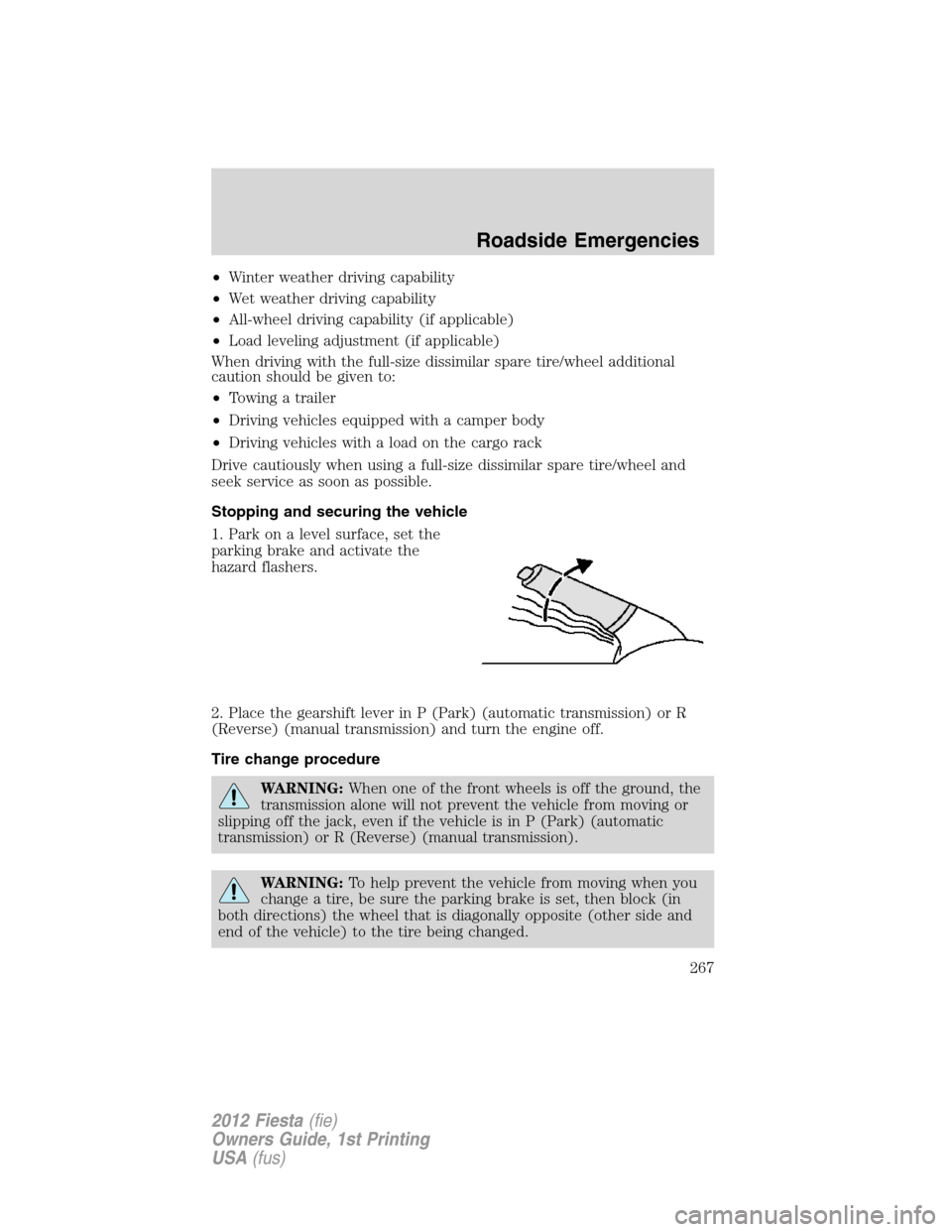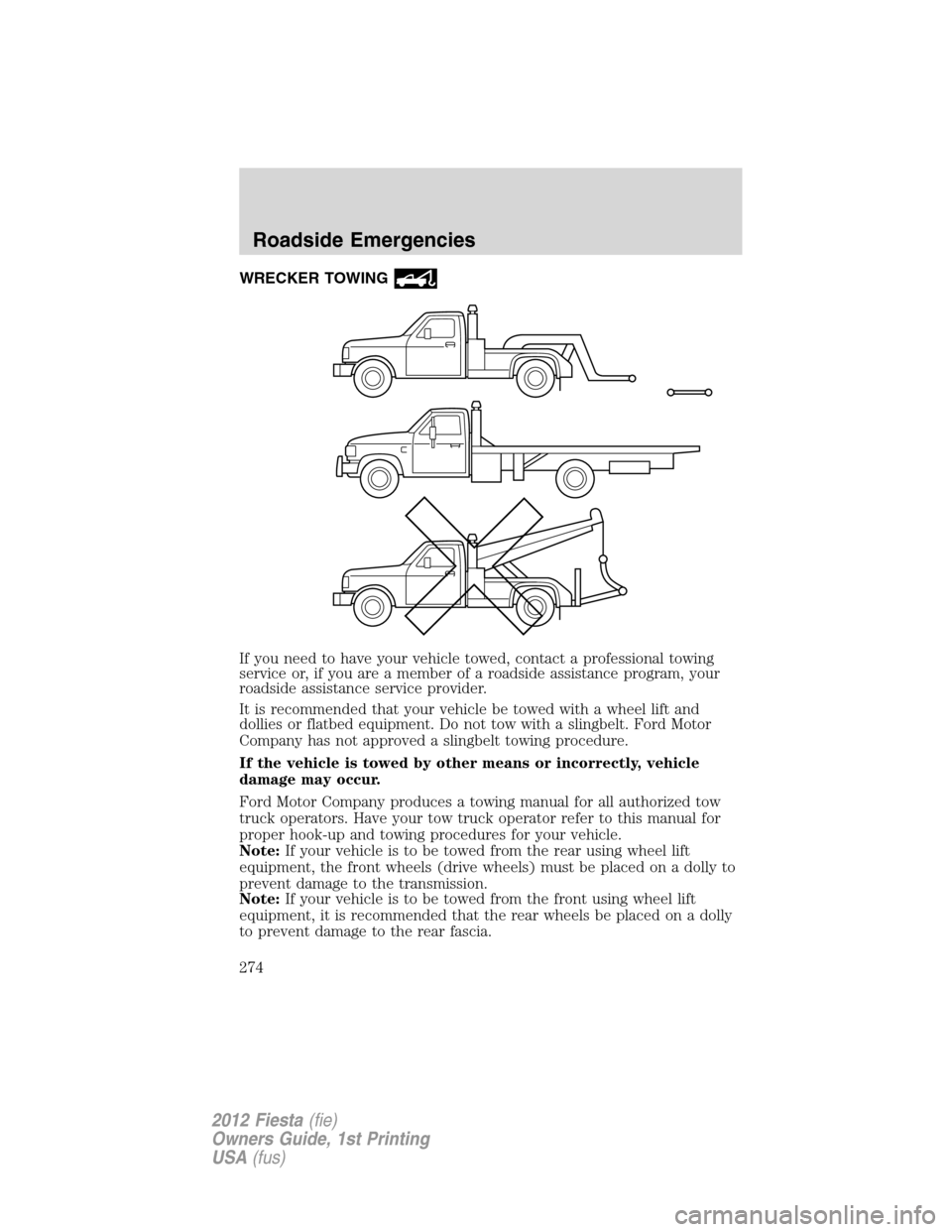Page 251 of 356

HILL START ASSIST (HSA) SYSTEM (IF EQUIPPED)
The hill start assist (HSA) system makes it easier to pull away when the
vehicle is on a slope without the need to use the parking brake. When
HSA is active, the vehicle will remain stationary on the slope for two to
three seconds after you release the brake pedal. During this time, you
have time to move your foot from the brake to the accelerator pedal and
pull away. The brakes are released automatically once the engine has
developed sufficient drive to prevent the vehicle from rolling down the
slope. This is an advantage when pulling away on a slope, (for example,
from a car park ramp, traffic lights or while in reverse traveling uphill
into a parking space).
WARNING:HSA does not replace the parking brake. When you
leave the vehicle, always apply the parking brake and select P
(Park) (automatic transmission) or neutral (manual transmission).
Using HSA
The HSA system is activated automatically when the vehicle is stopped
on a slope greater than four degrees. HSA operates with the vehicle
facing downhill if reverse gear is selected.
WARNING:You must remain in the vehicle once you have
activated HSA.
WARNING:During all times you are responsible for controlling
the vehicle, supervising the HSA system and intervening, if
required.
Activating HSA
1. Press the brake pedal to bring the vehicle to a complete standstill.
Keep the brake pedal pressed.
2. If the sensors detect that the vehicle is on a slope, the HSA system
will be activated automatically.
3. When you remove your foot from the brake pedal, the vehicle will
remain on the slope without rolling away for approximately two to three
seconds. This hold time will automatically be extended if you are in the
process of driving off.
Driving
251
2012 Fiesta(fie)
Owners Guide, 1st Printing
USA(fus)
Page 252 of 356

4. Drive off in the normal manner. The brakes will be released
automatically.
Note:If the engine is revved excessively, HSA will be deactivated.
Deactivating hill start assist
To deactivate HSA, perform one of the following:
•Apply the parking brake.
•Drive off uphill without re-applying the brake.
•Wait for two to three seconds until the HSA system deactivates
automatically.
•For automatic transmissions: If hill start assist is active in D (Drive),
select R (Reverse). If hill start assist is active in R (Reverse), select N
(Neutral).
•For manual transmissions: If a forward gear was selected when the
system became active, select reverse gear. If reverse gear was selected
when the system became active, select a forward gear.
Note:The HSA warning lamp (if
equipped) in the instrument cluster
momentarily illuminates when the
ignition is turned on. If a
malfunction is detected in the HSA system, HSA will be deactivated and
this warning lamp will appear on the instrument cluster.
Driving
252
2012 Fiesta(fie)
Owners Guide, 1st Printing
USA(fus)
Page 254 of 356
DRIVING THROUGH WATER
If driving through deep or standing
water is unavoidable, proceed very
slowly. Never drive through water
that is higher than the bottom of
the wheel rims (for cars) or the
bottom of the hubs (for trucks).
When driving through water, traction or brake capability may be limited.
Also, water may enter your engine’s air intake and severely damage your
engine or your vehicle may stall.Driving through deep water where
the transmission vent tube is submerged may allow water into the
transmission and cause internal transmission damage.
Once through the water, always dry the brakes by moving your
vehicle slowly while applying light pressure on the brake pedal.
Wet brakes do not stop the vehicle as quickly as dry brakes.
Driving
254
2012 Fiesta(fie)
Owners Guide, 1st Printing
USA(fus)
Page 260 of 356

Fuse/Relay
LocationFuse Amp
RatingProtected circuits
F8 7.5A Front dome lamp, Moon roof
switch
F9 20A Keyless vehicle module
F10 15A Radio, SYNC�module, Global
positioning system (GPS) module
F11 20A Front wipers, Body control
module (BCM)
F12 20A Tire pressure monitoring system
(TPMS)
F13 15A Rear wiper, BCM
F14 20A IA module
F15 15A Wiper switch
F16 7.5A Power mirror switch, Driver
window switch
F17 7.5A Heated seats (early build)
15A Heated seats (late build)
F18 10A Stop lamps, Turn signals
F19 7.5A Instrument cluster
F20 10A Airbag module
F21 10A BCM, Climate control, Passive
anti-theft system transceiver,
Electronic power steering module,
Instrument cluster, Engine
compartment fuse panel
F22 7.5A Accelerator pedal position sensor,
Powertrain control module
(PCM), Gear shifter, Anti-lock
brake system (ABS) ignition feed
F23 10A Transmission control unit ignition
feed, TPMS ignition feed
F24 — Not used
F25 7.5A Exterior mirrors
F26 7.5A TPMS
F27 — Not used
Roadside Emergencies
260
2012 Fiesta(fie)
Owners Guide, 1st Printing
USA(fus)
Page 262 of 356
If the battery has been disconnected and reconnected, refer to the
Batterysection of theMaintenance and Specificationschapter.
The high-current fuses are coded as follows:
Fuse/Relay
LocationFuse Amp
RatingProtected circuits
F1 40A* Anti-lock brake system (ABS) pump
F2 50A* Transmission control module (TCM)
F3 40A* Engine cooling fan relay and motor
F4 40A* Heater blower relay and motor
F5 60A* Passenger compartment fuse panel
F6 30A* Body control module (BCM) – door
locks
F7 60A* Passenger compartment fuse panel
F8 40A* Powertrain control module (PCM),
Power distribution box
F9 20A* ABS module valve
R11R8
R12R9
R5R3
R6R4
R13R10
R2R1
R15R14
R7
F41F35
F26F17F27F18F28F19F29F20F30F21F31F22F32F23F33F24F34F25
F42F36
F43F37
F44F38
F45F39
F40
F6F1
F7F2
F8F3
F9F4
F10F5
F14F11
F15F12
F16F13
F46
Roadside Emergencies
262
2012 Fiesta(fie)
Owners Guide, 1st Printing
USA(fus)
Page 267 of 356

•Winter weather driving capability
•Wet weather driving capability
•All-wheel driving capability (if applicable)
•Load leveling adjustment (if applicable)
When driving with the full-size dissimilar spare tire/wheel additional
caution should be given to:
•Towing a trailer
•Driving vehicles equipped with a camper body
•Driving vehicles with a load on the cargo rack
Drive cautiously when using a full-size dissimilar spare tire/wheel and
seek service as soon as possible.
Stopping and securing the vehicle
1. Park on a level surface, set the
parking brake and activate the
hazard flashers.
2. Place the gearshift lever in P (Park) (automatic transmission) or R
(Reverse) (manual transmission) and turn the engine off.
Tire change procedure
WARNING:When one of the front wheels is off the ground, the
transmission alone will not prevent the vehicle from moving or
slipping off the jack, even if the vehicle is in P (Park) (automatic
transmission) or R (Reverse) (manual transmission).
WARNING:To help prevent the vehicle from moving when you
change a tire, be sure the parking brake is set, then block (in
both directions) the wheel that is diagonally opposite (other side and
end of the vehicle) to the tire being changed.
Roadside Emergencies
267
2012 Fiesta(fie)
Owners Guide, 1st Printing
USA(fus)
Page 271 of 356

WARNING:Do not insert the nozzle of portable fuel containers
or aftermarket funnels into the Easy Fuel�system. This could
damage the fuel system and its seal, and may cause fuel to run onto
the ground instead of filling the tank, all of which could result in
serious personal injury.
JUMP STARTING
WARNING:The gases around the battery can explode if
exposed to flames, sparks, or lit cigarettes. An explosion could
result in injury or vehicle damage.
WARNING:Batteries contain sulfuric acid which can burn skin,
eyes and clothing, if contacted.
Do not attempt to push-start your automatic transmission
vehicle. Automatic transmissions do not have push-start
capability. Attempting to push-start a vehicle with an automatic
transmission may cause transmission damage.
Preparing your vehicle
When the battery is disconnected or a new battery is installed, the
automatic transmission must relearn its shift strategy. As a result, the
transmission may have firm and/or soft shifts. This operation is
considered normal and will not affect function or durability of the
transmission. Over time, the adaptive learning process will fully update
transmission operation.
1.Use only a 12–volt supply to start your vehicle.
2. Do not disconnect the battery of the disabled vehicle as this could
damage the vehicle’s electrical system.
3. Park the booster vehicle close to the hood of the disabled vehicle
making sure the two vehiclesdo nottouch. Set the parking brake on
both vehicles and stay clear of the engine cooling fan and other moving
parts.
4. Check all battery terminals and remove any excessive corrosion before
you attach the battery cables. Ensure that vent caps are tight and level.
5. Turn the heater fan on in both vehicles to protect from any electrical
surges. Turn all other accessories off.
Roadside Emergencies
271
2012 Fiesta(fie)
Owners Guide, 1st Printing
USA(fus)
Page 274 of 356

WRECKER TOWING
If you need to have your vehicle towed, contact a professional towing
service or, if you are a member of a roadside assistance program, your
roadside assistance service provider.
It is recommended that your vehicle be towed with a wheel lift and
dollies or flatbed equipment. Do not tow with a slingbelt. Ford Motor
Company has not approved a slingbelt towing procedure.
If the vehicle is towed by other means or incorrectly, vehicle
damage may occur.
Ford Motor Company produces a towing manual for all authorized tow
truck operators. Have your tow truck operator refer to this manual for
proper hook-up and towing procedures for your vehicle.
Note:If your vehicle is to be towed from the rear using wheel lift
equipment, the front wheels (drive wheels) must be placed on a dolly to
prevent damage to the transmission.
Note:If your vehicle is to be towed from the front using wheel lift
equipment, it is recommended that the rear wheels be placed on a dolly
to prevent damage to the rear fascia.
Roadside Emergencies
274
2012 Fiesta(fie)
Owners Guide, 1st Printing
USA(fus)